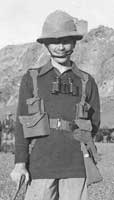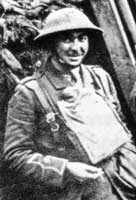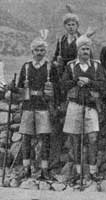| Karkee Web Home Page | Officer's Main Page | W.E.O. Main Page | W.E.I.O. Main Page |
Web Equipment, Infantry Officers
Introduction
 Despite two Great War advertisements, only one photograph is known of the 1916 version of W.E.O. (shown below right, of a King’s Regiment officer at Givenchy in March 1918). Doubtless there are other photographs, languishing in private albums and museum archives. Far more familiar, are examples of the later, updated Pattern, that Mills first showed in photographs dating from 1919. The young officer wearing W.E.I.O. in the photo at left is Lt. O.G. Brooke, 2nd Battalion, The Welch Regiment. This previously un-published photograph was taken at Landi Kotal, Khyber Pass, in January 1935, and is from an album in the Karkee Web Collection.
Despite two Great War advertisements, only one photograph is known of the 1916 version of W.E.O. (shown below right, of a King’s Regiment officer at Givenchy in March 1918). Doubtless there are other photographs, languishing in private albums and museum archives. Far more familiar, are examples of the later, updated Pattern, that Mills first showed in photographs dating from 1919. The young officer wearing W.E.I.O. in the photo at left is Lt. O.G. Brooke, 2nd Battalion, The Welch Regiment. This previously un-published photograph was taken at Landi Kotal, Khyber Pass, in January 1935, and is from an album in the Karkee Web Collection.
 Their original pattern of the Great War had shown distinct straight-line thinking, as regards the connections of a “back-adjustment” Belt. The Pistol case was a flat envelope, which made insertion of the revolver slightly more difficult. The sword, having been abandoned in 1914-15, had no provision made for it in the 1916 original. Post-war, the sword made its return as regulation wear, though not in the field.
Their original pattern of the Great War had shown distinct straight-line thinking, as regards the connections of a “back-adjustment” Belt. The Pistol case was a flat envelope, which made insertion of the revolver slightly more difficult. The sword, having been abandoned in 1914-15, had no provision made for it in the 1916 original. Post-war, the sword made its return as regulation wear, though not in the field.
During The Great War, a shortage of binoculars was addressed by an appeal for the general public to donate, or loan their binoculars. Many of these remained in military service, quite apart from any choice a new, post-war officer might make for his Private Purchase. Mills therefore made provision for the Binocular case to accommodate binoculars of differing sizes. Similarly, Pistol cases were offered in varying sizes and, as Mills made technical advances, changes in construction occurred. The finish of the various envelopes also evolved, from simple flaps, some with subsidiary weather flaps underneath, to box-lid forms.
 The Dress Regulations continued to list the Sam Browne Belt as regulation, but alongside this Web Equipment, Infantry Officers was also worn. For the most part this occurred in India, particularly on the North-West Frontier (the photo at left shows officers of the 2nd Battalion, 7th Dogra, wearing W.E.I.O.), but an instance has been noted of an officer in Germany wearing the pattern. This is at the end of the Rhineland Occupation – Germany being Foreign Service! KWRT Team Member John Bodsworth has analysed a number of Regimental Standing Orders for their instructions on field equipment. Loosely speaking, they are evenly divided between all-Sam Browne, or all-W.E., I.O., but never a mix of these within the Regiment. However, items designed for attachment, with dog-clips, to a Sam Browne Belt, such as Haversacks and Water bottle carriers, were allowed to be worn with W.E., I.O.. It should be remembered that the Army version had Brace ends available for the W.E., I.O. Haversack and Bottle carrier. Other than for a sword, in Review Order, the brass dees on the Brace attachments and Back adjustment strap had no use, other than to be specifically compatible with items designed for Sam Browne use.
The Dress Regulations continued to list the Sam Browne Belt as regulation, but alongside this Web Equipment, Infantry Officers was also worn. For the most part this occurred in India, particularly on the North-West Frontier (the photo at left shows officers of the 2nd Battalion, 7th Dogra, wearing W.E.I.O.), but an instance has been noted of an officer in Germany wearing the pattern. This is at the end of the Rhineland Occupation – Germany being Foreign Service! KWRT Team Member John Bodsworth has analysed a number of Regimental Standing Orders for their instructions on field equipment. Loosely speaking, they are evenly divided between all-Sam Browne, or all-W.E., I.O., but never a mix of these within the Regiment. However, items designed for attachment, with dog-clips, to a Sam Browne Belt, such as Haversacks and Water bottle carriers, were allowed to be worn with W.E., I.O.. It should be remembered that the Army version had Brace ends available for the W.E., I.O. Haversack and Bottle carrier. Other than for a sword, in Review Order, the brass dees on the Brace attachments and Back adjustment strap had no use, other than to be specifically compatible with items designed for Sam Browne use.
Advances in design meant Patt. ’19 W.E. had a Haversack, with provision for it to be carried on the wearer’s back. This was read-across to the new W.E., I.O. Haversack now provided. All in all, Web Equipment for Officers received quite a make-over, providing a modern set of accoutrements for officers when, as one contemporary remarked after the Armistice, the British Army got back to the business of “…real soldiering…”!!
The chronology of the different Issues is necessarily speculative, since more dated examples are required to pin down the dates. This is particularly important with the Binocular case, so the more examples readers can bring to our attention, the better.
Rog Dennis, August 2010